In a world dominated by screens and a growing dependency on close-up activities, the prevalence of myopia, or nearsightedness, has significantly arised. Myopia, characterized by difficulty in seeing distant objects clearly, is a widespread refractive error affecting millions worldwide and is stated that by 2050 one out of two persons will be myopic. Therefore, this blog aims to unravel the intricacies of myopia, delving into what is myopia, its causes, symptoms, and available myopia treatment options. From the diagnosis to corrective and preventive measures, this comprehensive guide seeks to empower readers with a holistic understanding of myopia and its management.
What is Nearsightedness (Myopia)?
Nearsightedness, scientifically known as myopia, is a common refractive error affecting the eyes that hinders the ability to see distant objects clearly. This vision condition occurs when light entering the eye focuses in front of the retina instead of directly on it.
In a normally functioning eye, the light passes through the cornea and lens, converging precisely on the retina to form a clear image. However, in individuals with myopia, the eyeball is either too long or the cornea is overly curved. As a result, the ray of light falls in front of the retina, leading to blurred vision when attempting to view objects at a distance.
What Causes Nearsightedness?
Myopia or nearsightedness is caused by a combination of genetic, environmental, and lifestyle factors. Key contributors include:
Environmental Factors:
- Limited Outdoor Exposure: Insufficient time outdoors during childhood is associated with a higher prevalence.
- Urbanization: Urban environments with limited green spaces and outdoor recreational areas may contribute to myopia. Studies suggest a correlation between urban living and a higher prevalence of nearsightedness.
Lifestyle Choices:
- Close-Up Activities: Prolonged screen time and intense close-up activities increase the risk.
- Visual Hygiene: Poor visual habits, like reading in low light, can impact myopia development.
Other Risk Factors:
- Age: Myopia often starts in childhood, stabilizing in adulthood but posing risks if severe.
Understanding these nearsightedness causes helps developing tailored preventive measures, emphasizing lifestyle modifications and early detection through regular eye examinations for effective myopia management.
What are the Symptoms of Nearsightedness?
Recognizing nearsightedness symptoms involves being attentive to common signs:
- Blurry Distance Vision: Difficulty seeing distant objects clearly.
- Eye Strain: Discomfort and achy eyes, especially after prolonged close-up tasks.
- Headaches: Headaches, often triggered by eye strain.
- Squinting: Unconscious squinting to enhance focus on distant objects.
- Difficulty Seeing at Night: Reduced night vision, making low-light conditions challenging.
- Frequent Prescription Changes: Regular need for updates in eyeglass or contact lens prescriptions as myopia progresses.
Regular eye check-ups help in early detection of nearsightedness symptoms, ensuring timely intervention for improved vision and minimizing potential complications. If these symptoms are observed, consulting an eye care professional is recommended.
Are there any Associated Risks with Nearsightedness?
Nearsightedness, or myopia can showcase symptoms beyond simple blurry vision and can pose certain risks, especially when left untreated or unchecked. Understanding these associated risks is crucial for comprehensive eye care:
- Eye Strain and Discomfort: Individuals with myopia may experience chronic eye strain and discomfort, particularly during activities requiring prolonged screen time, leading to a reduced quality of life.
- Compromised Academic and Work Performance: In children as well as adults, uncorrected myopia can impact academic and work performance. Difficulty seeing clearly at a distance may hinder learning and productivity.
- Increased Risk of Accidents: Poor distance vision, especially at night, can elevate the risk of accidents, both during activities like driving and in other day-to-day situations.
- Progression to High Myopia: High myopia, characterized by a severe degree of nearsightedness, carries additional risks. The elongation of the eyeball in high myopia increases the likelihood of eye complications.
To mitigate these risks, early detection through regular eye examinations is crucial. Proper corrective measures, such as eyeglasses, contact lenses, or refractive surgeries, can address myopia and reduce associated risks.
Diagnosis of Nearsightedness?
Accurate diagnosis of nearsightedness (myopia) involves:
Visual Acuity Testing: Assessing clarity at various distances using standard eye charts.
Refraction Test: Determining the lens prescription for clear vision, revealing the degree of myopia.
Retinoscopy: Using a light beam to estimate refractive error and prescribe corrective lenses.
Comprehensive Eye Health Exam: Examining the health of the eyes, including the retina and optic nerve.
Eye Length Measurement: Specialized techniques like ocular biometry may be used to measure eyeball length, especially for monitoring myopia progression.
Regular eye check-ups, especially for children, enable early detection and timely intervention for effective myopia management. Routine examinations also monitor prescription changes and identify potential complications, ensuring optimal eye health.
Corrective Options: How to Cure Nearsightedness?
While there is no permanent cure for nearsightedness (myopia), various corrective options effectively address this refractive error. These options aim to improve distance vision and provide clarity. Common corrective measures include:
Eyeglasses: Prescribed eyeglasses are a primary and non-invasive solution for correcting myopia. They compensate for the refractive error by adjusting the way light enters the eyes, allowing for clear distance vision.
Contact Lenses: Contact lenses, available in various types including soft, rigid gas permeable, and specialty lenses, offer an alternative to eyeglasses. They fix directly on the eye’s surface, providing a wider field of view and eliminating the cosmetic aspect associated with glasses.
Refractive Surgery: Refractive surgeries, such as SILK, SMILE, Contoura Vision, LASIK, Custom Eyes LASIK for myopia and PRK, reshape the cornea permanently to correct myopia. Beside them, there is an option for ICL surgery, in which an artificial lens of the prescribed eye power is fixed behind the iris of the eye. These surgeries offer a long-term solution, reducing or eliminating the need for glasses or contact lenses.
It’s important to know that while these corrective options effectively correct myopia, they do not eliminate the underlying factors causing nearsightedness. Additionally, the suitability of each option depends on factors like the degree of myopia, individual eye health, and lifestyle preferences.
Non Surgical Treatment Options
Eyeglasses and Contact Lenses:
Prescription eyeglasses and contact lenses are traditional and effective non-surgical solutions for myopia.
Orthokeratology (Ortho-K):
Overnight use of special contact lenses reshapes the cornea temporarily, providing clear daytime vision without corrective lenses.
Multifocal Lenses:
Contact lenses or eyeglasses with multifocal options address both myopia and other refractive errors.
Vision Therapy:
Eye exercises may be recommended to improve eye coordination and focus in certain cases of myopia.
Surgical Treatment Options
Refractive Surgeries: Laser procedures reshape the cornea, offering a quick recovery and reduced dependence on corrective lenses.
Implantable Collamer Lenses (ICL) and Refractive Lens Exchange (RLE): Surgical options involve implanting artificial lenses to correct myopia, suitable for varying degrees of nearsightedness.
Both non-surgical and surgical approaches provide effective solutions for managing nearsightedness. However, the choice between surgical and non-surgical options depends on factors like the severity of myopia, eye health, and individual preferences. Also, one must consult with the eye surgeon prior to arriving at the final decision.
How to Prevent Myopia?
Preventing The progression of myopia involves adopting lifestyle practices and environmental changes. These proactive measures can help reduce the risk of developing nearsightedness:
Outdoor Activities: Encourage outdoor activities, especially during childhood and adolescence. Spending time outdoors, exposed to natural light, has been associated with a lower risk of myopia.
Frequent Eye Breaks: Implement the 20-20-20 rule for screen time. Every 20 minutes, take a 20-second break, and look at something 20 feet away. This helps reduce eye strain associated with close-up work.
Limited Screen Time: Manage and limit screen time, particularly for children. Excessive use of digital devices has been linked to an increased risk of myopia.
Proper Lighting: Ensure adequate lighting when engaging in close-up activities like reading or studying. Well-lit environments reduce eye strain.
Balanced Diet: Promote a diet rich in nutrients beneficial for eye health, including vitamins A, C, and E, as well as omega-3 fatty acids. Consult with a healthcare professional for dietary guidance.
Regular Eye Check-ups: Schedule regular eye examinations, especially for children. Early detection allows for timely intervention and management of myopia.
These preventive measures collectively contribute to creating an environment that reduces the risk of myopia.
Complications
While myopia itself is a common refractive error, high or unmanaged levels of nearsightedness can lead to various complications, such as:
Retinal Detachment: High myopia is associated with an increased risk of retinal detachment, a serious eye condition that requires immediate medical attention.
Glaucoma: Myopia, particularly of high eye power, has been linked to an elevated risk of developing glaucoma, a condition that can lead to optic nerve damage and vision loss.
Cataracts: Some studies showcase interlinking between myopia, especially high myopia, and an increased risk of developing cataracts over time.
Macular Degeneration: High myopia may contribute to a higher risk of age-related macular degeneration, a progressive eye disease affecting the central part of the retina.
FAQs
How often should I have my eyes checked for myopia?
It’s recommended to have a comprehensive eye exam annually, especially for children and those with a family history of myopia.
What lifestyle and home remedies can help manage myopia?
Outdoor activities, frequent breaks during close-up work, and maintaining proper lighting can aid in managing myopia. However, these are complementary to professional eye care.
Is myopia a progressive condition, and can it worsen over time?
Yes, myopia is often progressive, especially during childhood and adolescence. Regular eye check-ups are essential to monitor changes and adjust prescriptions accordingly.
Can myopia lead to blindness?
While myopia itself doesn’t lead to blindness, high or unmanaged myopia increases the risk of serious eye conditions like retinal detachment and macular degeneration, which can result in vision loss. Regular eye care is crucial for prevention and early intervention.





